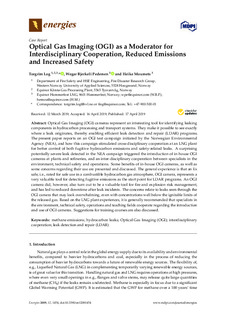| dc.contributor.author | Log, Torgrim | |
| dc.contributor.author | Pedersen, Wegar Bjerkeli | |
| dc.contributor.author | Moumets, Heike | |
| dc.date.accessioned | 2019-05-31T12:34:50Z | |
| dc.date.available | 2019-05-31T12:34:50Z | |
| dc.date.created | 2019-05-04T08:32:45Z | |
| dc.date.issued | 2019 | |
| dc.identifier.citation | Log, T., Pedersen, W. B., & Moumets, H. (2019). Optical gas imaging (OGI) as a moderator for interdisciplinary cooperation, reduced emissions and increased safety. Energies, 12(8). | nb_NO |
| dc.identifier.issn | 1996-1073 | |
| dc.identifier.uri | http://hdl.handle.net/11250/2599566 | |
| dc.description.abstract | Optical Gas Imaging (OGI) cameras represent an interesting tool for identifying leaking components in hydrocarbon processing and transport systems. They make it possible to see exactly where a leak originates, thereby enabling efficient leak detection and repair (LDAR) programs. The present paper reports on an OGI test campaign initiated by the Norwegian Environmental Agency (NEA), and how this campaign stimulated cross-disciplinary cooperation at an LNG plant for better control of both fugitive hydrocarbon emissions and safety-related leaks. A surprising potentially severe leak detected in the NEA campaign triggered the introduction of in-house OGI cameras at plants and refineries, and an inter-disciplinary cooperation between specialists in the environment, technical safety and operations. Some benefits of in-house OGI cameras, as well as some concerns regarding their use are presented and discussed. The general experience is that an Ex safe, i.e., rated for safe use in a combustible hydrocarbon gas atmosphere, OGI camera, represents a very valuable tool for detecting fugitive emissions as the start point for LDAR programs. An OGI camera did, however, also turn out to be a valuable tool for fire and explosion risk management, and has led to reduced downtime after leak incidents. The concerns relate to leaks seen through the OGI camera that may look overwhelming, even with concentrations well below the ignitable limits of the released gas. Based on the LNG plant experiences, it is generally recommended that specialists in the environment, technical safety, operations and teaching fields cooperate regarding the introduction and use of OGI cameras. Suggestions for training courses are also discussed. | nb_NO |
| dc.language.iso | eng | nb_NO |
| dc.publisher | MDPI | nb_NO |
| dc.rights | Navngivelse 4.0 Internasjonal | * |
| dc.rights.uri | http://creativecommons.org/licenses/by/4.0/deed.no | * |
| dc.subject | methane emissions | nb_NO |
| dc.subject | hydrocarbon leaks | nb_NO |
| dc.subject | Optical Gas Imaging (OGI) | nb_NO |
| dc.subject | interdisciplinary cooperation | nb_NO |
| dc.subject | leak detection and repair (LDAR) | nb_NO |
| dc.title | Optical Gas Imaging (OGI) as a Moderator for Interdisciplinary Cooperation, Reduced Emissions and Increased Safety | nb_NO |
| dc.type | Journal article | nb_NO |
| dc.type | Peer reviewed | nb_NO |
| dc.description.version | publishedVersion | nb_NO |
| dc.rights.holder | © 2019 by the authors. | nb_NO |
| dc.source.pagenumber | 13 | nb_NO |
| dc.source.volume | 12 | nb_NO |
| dc.source.journal | Energies | nb_NO |
| dc.source.issue | 4 | nb_NO |
| dc.identifier.doi | 10.3390/en12081454 | |
| dc.identifier.cristin | 1695574 | |
| cristin.unitcode | 203,12,2,0 | |
| cristin.unitname | Institutt for brannsikkerheit og HMS | |
| cristin.ispublished | true | |
| cristin.fulltext | original | |
| cristin.qualitycode | 1 | |

